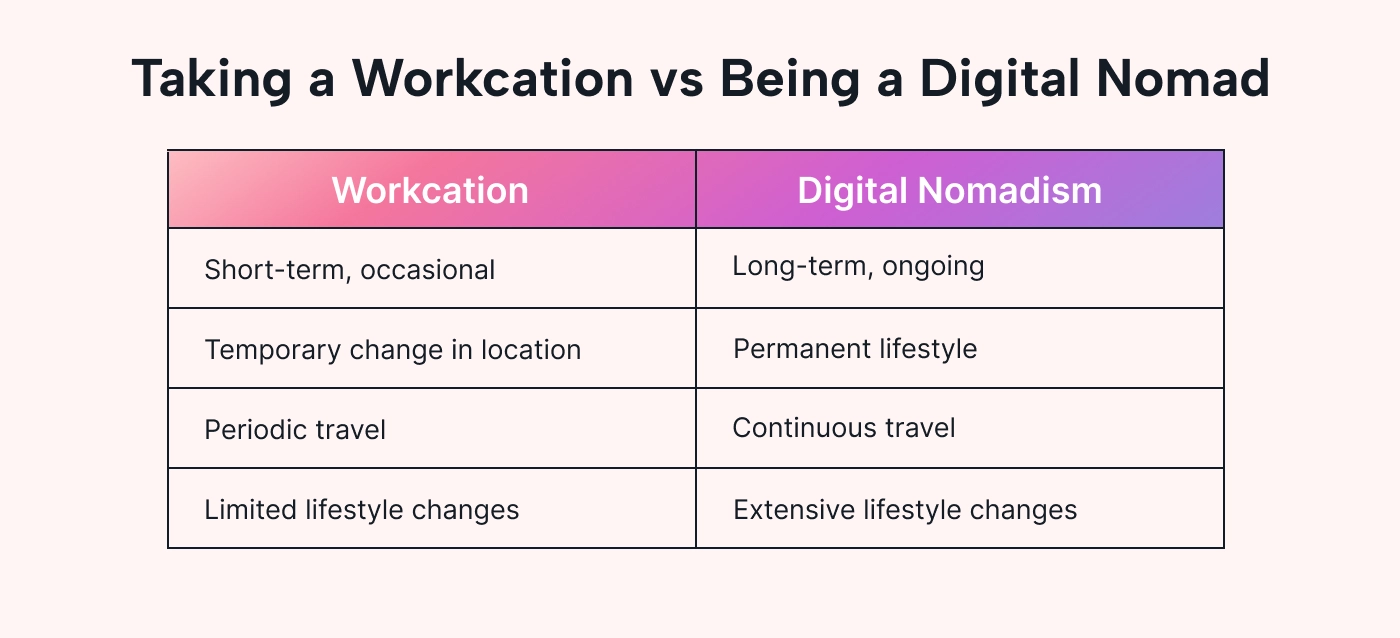A vacation can do all that and more. But what if you don’t want to fall behind with your workload?
You can reset and stay productive with a “workcation.”
Workcations (or work vacations) offer a refreshing twist to your daily routine. They make it possible to regenerate in inspiring places while staying caught up on work. They can even give you the upward swing you need to take your career to the next level.
In this article, we show you how to plan and execute the perfect workcation — one that allows you to stay connected and productive while you recharge your batteries in new, exciting places.
What is a workcation?
A workcation represents a trend in flexible working where employees combine their work responsibilities with a vacation.
During a workcation, you can experience new environments and cultures — but without needing to take time off from work. You get a boost in inspiration and creativity in the process.
Workcations are so attractive that millions of Americans are hopping on board — the younger generations especially. In fact, in 2023, more than 25% of Americans were planning on taking a workcation — including half of Gen Z-ers, 26% of Millennials, 24% of Gen X-ers, and 22% of Baby Boomers.
This same study found that more than 35% “have taken a blended work and travel vacation before and nearly 60% say they’re just as productive as they’d be at home. When on these blended trips and not working, the top things travelers want to do are relax, try new restaurants or cuisine and sightsee.”
Workcation arrangements can vary from short-term stays at a single location to longer-term travels to multiple destinations. The sky’s the limit!
What is an example of a workcation?
Imagine a software developer named Alex who decides to take a two-week workcation in Bali, Indonesia. They stay at a beachfront villa equipped with high-speed internet — a perfect setup for both work and leisure.
Think of half a day of focused, productive coding sessions on the villa's terrace, sandwiched between an invigorating morning swim in the ocean, yoga classes, day trips to ancient temples, and checking out the local cuisine.
 |
HR manager Alice, on the other hand, is looking for a more learning-oriented workcation experience. She books a three-week trip to Paris, where she takes a self-development course and some French language classes.
Equipped with new skills and new friends, Alice spends her downtime exploring art and architecture. She also makes time for deep thinking and lively discussions about one of her personal interests: finding sustainable solutions for various environmental problems.
Both Alex and Alice experience a strong sense of rejuvenation in their respective workcations. Though very different, their workcations give each of them the exact boost in the vision and creativity they need.
How many different types of workcations are there?
When you hear the word “workcation,” one of the first ideas that might come to mind is staying in an exotic locale — maybe with a warm, sunny beach. Hawaii, anyone?
But there are different types of workcations. To whet your appetite, here are some common ones:
1. Nature retreat workcation
Set in natural surroundings, such as mountains, forests, or near bodies of water, nature retreat workcations are ideal for those who want to escape urban life and enjoy outdoor activities like hiking, swimming, horseback riding, or just relaxing in nature.
Focus: Stress relief, connection with nature, and physical activity
2. Urban exploration workcation
An urban exploration workcation involves staying in a different city to explore cultural sites, restaurants, and nightlife while continuing to work.
Focus: Cultural immersion, gastronomy, arts, and entertainment
3. Beach workcation
A beach workcation is perfect for enjoying sun, sand, and sea — a rejuvenating experience.
Focus: Relaxation, water activities, and sunbathing.
4. Wellness and spa workcation
Here, you stay at a wellness resort or attend a spa retreat that offers activities like yoga, meditation, spa treatments, and healthy eating.
Focus: Health, relaxation, and self-care
5. Adventure workcation
Thrill-seekers will love adventure workcations, where they can engage in skiing, surfing, mountain biking, kayaking, rafting, bungee jumping, and other daredevil activities.
Focus: Adventure sports, exploration, and adrenaline-fueled activities
6. Cultural immersion workcation
Cultural immersion workcations are great for those who want to deepen their understanding of particular cultures. The experience might include language-learning opportunities, cooking classes, and staying with local families.
Focus: Cultural learning, foreign languages, and community immersion
7. Educational workcation
Educational workcations combine work with learning opportunities, such as workshops, conferences, or short courses in areas of interest. They can be particularly enriching, both professionally and personally.
Focus: Professional development, skill acquisition, and education
Each of these types of workcations offers a different blend of work and leisure time. Choose one that works for you — or mix and match them to build your own unique one.
Does taking a workcation make you a digital nomad?
Sorry, but no — taking a workcation doesn’t earn you the moniker of “digital nomad.”
Here’s the difference between the two:
 |
Workcations
Workcations are typically short-term, from a few days to a few weeks in length. They're like traditional vacations — but with the addition of work responsibilities.
Taking a workcation means you temporarily shift your work location to a vacation spot or a destination you want to explore. The temporary change of scenery is potentially more relaxing than your regular work location.
Workcations require minimal lifestyle changes. The main goal is a refreshing change of pace rather than a complete life overhaul.
Digital nomadism
Digital nomadism is a lifestyle choice where individuals work remotely on a long-term basis. They often move from one location to another over months or even years, usually without a fixed home base.
Becoming a digital nomad changes how you balance and manage your work, your personal life, and logistics such as accommodation, healthcare, and taxes.
 |
What are the benefits and drawbacks of workcations?
The workcation idea brings lots of benefits with it, though it does have some drawbacks to consider. Let’s take a look at some of both.
Benefits
- Changing your environment can stimulate creativity and productivity. The new sights, sounds, and experiences tend to inspire fresh ideas and perspectives, which can be particularly beneficial if you’re a creative professional.
- The opportunity to work in a more relaxed setting can reduce stress and prevent burnout. This can generate a healthier state of mind and a better work-life balance.
- Workcations offer you the flexibility to design a work schedule around your personal work preferences. This autonomy can improve your sense of being in control of your life and give you more job satisfaction.
- Traveling to new locations offers you a chance to experience different ways of life and make new friends, which can broaden your horizons and enrich your life.
Drawbacks
- As with other types of remote work, the lines between work and time off (your vacation time, in this case) can become blurry. This can make it difficult to fully disconnect and relax — to the point where you’re neither feeling fully on vacation nor fully focused on your work.
- Dependence on internet connectivity can be a challenge, especially in remote or less-developed destinations.
- Even with the best intentions, managing work responsibilities while on the road to a new destination can be stressful and unproductive — so you may lose precious work time while traveling.
- The cost of travel, accommodation, and activities can add up. If you’re not careful, these expenses can turn workcations into an unexpected financial burden.
In short, while workcations are a unique way to reinvigorate your work and personal life, plan them carefully to make the most of these opportunities while successfully working around the potential drawbacks.
 |
How do I stay productive during a workcation?
Good question. After all, it’s a work vacation, so you still have to keep your work commitments while you’re away from your normal work location.
Here are some best practices for staying productive and organized:
Establish clear work goals
While on the road, you won’t be able to do everything you’d normally accomplish in a day. So, set clear goals for the work projects and tasks you intend to focus on during your workcation.
Set a schedule
Set clear work hours that match your peak productivity times. For instance, say you’ll work four hours per day, from 9 am to 1 pm. Then, schedule your leisure activities around your work schedule. Stick to this routine to get all your work time in.
Incorporate time for deep work
Workcations provide a wonderful opportunity for deep work — focused, uninterrupted attention on the parts of your work that matter most. Identify your ideal times for deep work and build them into your schedule.
Use project management software
While away on a workcation, you run the risk of getting distracted from work by your new experiences.
Intelligent project management software like Motion’s Project Manager, which easily adjusts to new work schedules, is designed to keep you on track, even if you’re on the other side of the world.
How do I request a workcation?
While how to ask for a workcation will depend on the company you work for, here’s the general process to follow:
1. Do the initial planning
Research your plan, including your destination, accommodations, and how you’ll manage your work responsibilities. Also, check on how many vacation days you have in your PTO bank.
2. Prepare a proposal
Draft a proposal that includes the details and benefits of your workcation. Include the following information:
- How long you plan to be gone
- Your work schedule (how many hours per day or week you’re dedicating to work time vs when you’ll take vacation hours)
- Projects you propose to work on while away
- A communication plan for staying in touch with the office (as needed)
- How you’ll handle working from a different time zone (if applicable)
- How you plan to stay accountable and productive while you’re away
3. Get approval in writing
If your workcation is approved, make sure that you get the agreement in writing and that the details on the terms and duration are accurate. This document should also clarify your supervisor’s expectations and any other conditions for your workcation.
 |
What kind of setup do I need at my workcation address?
Even if you’re “workcationing” at a faraway place, the setup you need to stay connected and productive is not so different from what you’d use when working from home.
Here’s a basic list:
Reliable internet connectivity
At the top of the list is internet speed and a reliable, secure connection for accessing cloud services, joining virtual meetings, and staying in touch with your teammates.
Look for accommodations or coworking spaces that offer dedicated Wi-Fi for guests, preferably with information on bandwidth or speed tests.
A stable power net
Power supply stability is another consideration, especially in remote places or regions prone to outages. Check that the location has a backup power solution, such as a generator.
Make sure there are enough power outlets in the room where you’ll be working — or bring an extra power strip for your devices.
A quiet workspace
Vacation destinations with lots of people around can be noisy, so it’s important to find a quiet, comfortable workspace where you can work for extended periods without distractions.
Ergonomics also plays a role here. You can only sit for so long with your back against a palm tree, so make sure your room has a proper chair and desk setup for your work sessions.
What should I pack for a workcation?
In addition to your clothing, PJs, toiletries, and a good book, here’s our checklist for what to pack to be ready for work once you arrive at your destination.
- Laptop and charger
- Smartphone
- Lightweight external keyboard and mouse (to reduce the strain from long hours of work on a laptop)
- Portable Wi-Fi device or SIM card to connect to local Wi-Fi networks (don’t forget the SIM card remover tool)
- Power adapters and converters (check on the voltage and types of power outlets at your destination)
- Noise-canceling headphones (for focused work sessions and clear audio during virtual meetings, especially in noisy environments)
- USB drives, external hard drives, or cloud storage access (for file backups to prevent lost work).
- Essential login information and passwords (to access your work apps, online bank account, etc.)
- Small notebook, pencils/pens, and sticky notes (for jotting down ideas or reminders when you're away from your digital devices)
 |
For the best workcations, use a reliable online calendar
Workcations are a powerful way to rejuvenate while staying connected to your work and maintaining your income stream.
But when you’re at your workcation destination, it’s easy to lose track of where you are at with your tasks and projects. It’s also easy to lose sight of the special goals you had set for yourself, such as coming up with new ideas for your team, your business, or your career path.
That’s where an online calendar is indispensable.
Motion’s AI-driven, intelligent calendar is a super-helpful tool wherever you work. Fill in your aspirations and goals, and this interactive calendar adjusts your schedule so you can perform at your best, even when you’re far from home.
To get started, try Motion for free.

A certified content writer and SEO strategist, Carla Groenewegen writes about success principles and practices aimed at SMBs and not-for-profit organizations.




